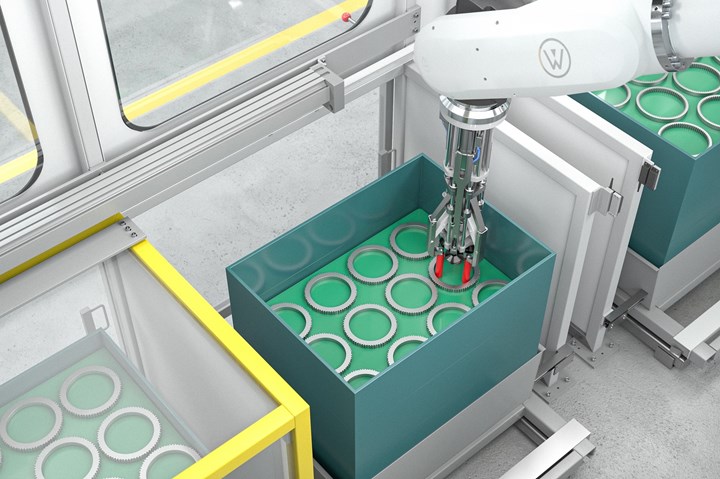Wickert multifunctional gripper improves automated workpiece handling
Set-up free gripper handles multilayer-stacked components uses cameras, image processing and an integrated position sensor system for uninterrupted handling, automation and machining operations.

Multifunctional gripper in action. All photo credit: Wickert Maschinenbau GmbH
On May 3, Wickert Maschinenbau GmbH (Landau, Germany) announced the development of a compact, setup-free multifunctional gripper for the handling of multilayer-stacked or chaotically deposited components with layer separation.
The system is available with two different gripper types. A group of two to six fingers pick up workpieces and lift them out of the transport container. As soon as one layer has been completely emptied, the separation sheet is removed by three close-fitting, extendable vacuum suction elements on the gripper arm. The system is then able to access the next level of components.
According to the company, the multifunctional gripper can be used without additional programming. With the help of cameras, image processing and an integrated position sensor system, the multifunctional gripper is able to consistently detect both the inside diameter and position of components —which the programmable logic controller (PLC) compares with the gripper diameter, and centrally stores for later — as well as monitor the remaining quantities and detects when a layer of components is empty. Additionally, the system employs a plausibility check to decide on the suitability of workpieces for further processing. Any components that are clearly inappropriate or falsely gripped are thus detected reliably and are not fed in for further processing.
Further, the gripper’s space-saving, setup-free design, is said to enable the automated handling of components and uninterrupted production even in confined spaces, as no additional space is required for gripper changer systems in the production cell. Thanks to its flexibility, Wickert says, the gripper is suitable for a variety of different applications in handling, automation and machining operations.
In the standard version, the compact multifunctional gripper is designed for rotation-symmetrical workpieces with inside diameters from 40-256 mm and weights between 100 g and 20 kg. For other requirements, the parameters can be configured individually. Grippers with larger arms, for combined outside and inside gripping, can also be provided on request.
The standard version of the gripper arm has a height of 730 mm and a 160-mm diameter, which further enables the gripper to precisely pick and place small components even when they are tightly packed on a pallet, or located in the corners of pallets. If a workpiece has slipped into a position that is not accessible to the gripper, the fingers move it back into a position where it can be reached.

Wickert notes that the gripper fingers have a wide lift range. The surfaces which come into contact with the product are equipped with a wear-resistant rubber coating which ensures a high friction value and reliable grip. In accordance with individual requirements, the gripper pressure can be set individually to a value between 460 and 3000 N. This ensures that both heavy and light components, as well as delicate components, can be gripped reliably and without being damaged. As an option, the gripper fingers can also be fitted with an interlocking under-grip.
Related Content
-
Airborne delivers composite upper stage tank for EU ENVOL project
Nine-member consortium targets development of low-cost, green vertical orbital launcher with manufacture of an ultra-lightweight composite tank design in an automated manufacturing environment.
-
Broetje-Automation demonstrates rCF placement via AFP
Through the ScrapSeRO project, the system integrator and machine builder successfully processed recycled composites, in addition to more traditional materials, via its highly flexible Staxx One system.
-
How AI is improving composites operations and factory sustainability
Workforce pain points and various logistical challenges are putting operations resilience and flexibility to the test, but Industry 4.0 advancements could be the key to composites manufacturers’ transformation.














